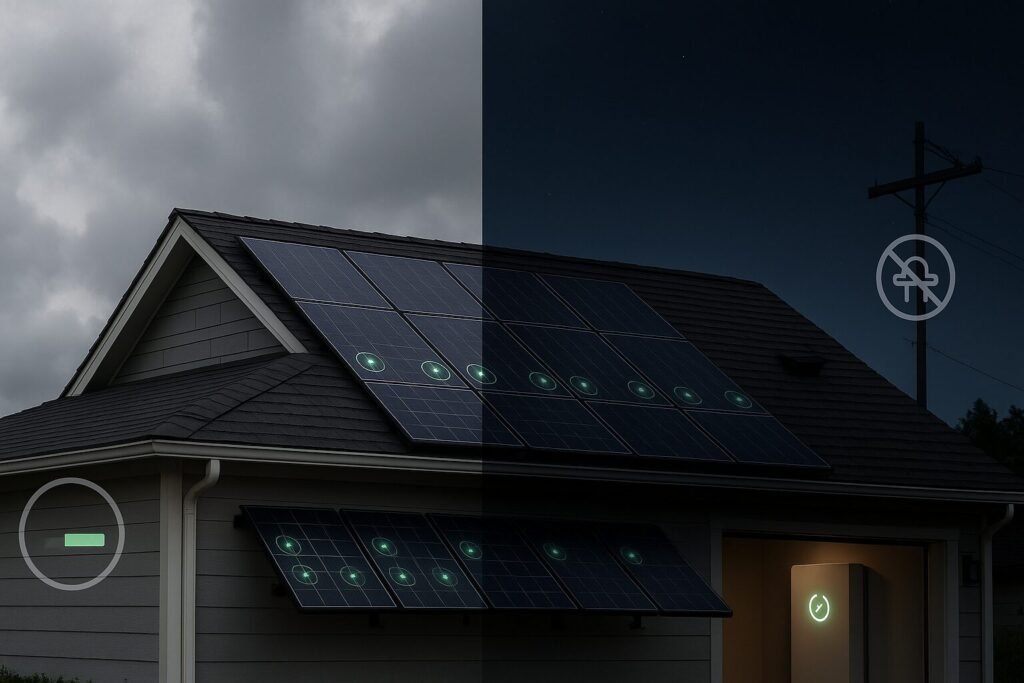Do Solar Panels Work at Night? Cloudy-Day Truths
Do solar panels work at night? Learn what happens on cloudy days, how batteries bridge the gap, and why design choices boost low-light output and backup.
My Rainy-Week Wake-Up Call
A few winters ago, we had five straight days of rain. I opened my solar app, saw a sad little production curve, and thought, “Uh oh—did something break?” It hadn’t. The system was fine. I just learned, the hard way, that solar isn’t about one perfect sunny hour. It’s about the total energy (kWh) you gather over many imperfect hours—clouds and all.
In this post, I’ll share what actually happens to solar panels in overcast weather and at night, how batteries bridge the gap, and how smart design (microinverters, layout, and settings) keeps your home comfortable year-round.
Skimmer Stop: TL;DR Snapshot
- Cloudy ≠ zero. Expect ~10–60% of clear-sky output depending on how thick the clouds are.
- Night = no PV. You’ll need the grid, a battery, or a generator.
- Blackouts: Grid-tied solar shuts off for safety unless you have a battery/backup setup.
- Design matters: Microinverters/optimizers + good layout = better low-light performance.
LSI sprinkles you’ll see naturally here: diffuse irradiance, low-light performance, partial shading losses, module mismatch, MLPE (module-level power electronics), capacity factor, winter insolation, time-of-use (TOU), depth of discharge (DoD), and round-trip efficiency.
Solar 101 in 90 Seconds
Solar panels turn photons into DC power, and your inverter converts that to AC for your home. On clear days, most light is direct. On cloudy days, much of it is diffuse irradiance—still useful, just weaker. That’s why you’ll see lower power (kW) at any moment on a gray day, but can still collect meaningful energy (kWh) across the whole day.
Glossary in Plain English
- kW vs kWh: kW is “how fast right now,” kWh is “how much over time.”
- Irradiance: sunlight intensity hitting the panels.
- Production vs consumption: what your system makes vs what your home uses.
Cloudy vs. Sunny: How Much Power Do You Actually Get?
Here’s a practical rule of thumb I use when explaining low-light performance:
| Cloud Condition | Typical % of Clear-Sky Output* |
|---|---|
| Light overcast / bright clouds | ~40–60% |
| Medium overcast | ~25–40% |
| Light overcast/bright clouds | ~10–25% |
| Broken clouds (“edge-of-cloud” lensing) | Brief spikes possible |
*These are ballpark ranges—your roof angle, temperature, panel type, and shading all nudge the numbers.
Key idea: It’s the total kWh that matters. A cloudy day may look weak at noon, but it can still add up if you gather energy slowly all day.
Skimmer Box – One Number to Remember:
Plan on ~25–60% of sunny-day output across typical cloudy days.
Nighttime Reality Check: Moonlight, Streetlights & Myths
This one’s simple: panels don’t produce meaningful electricity at night. Moonlight and streetlights are far too dim to register useful output. At night, you’re powered by the grid, a home battery, or a generator—not your PV array.
Will I Have Power in a Blackout if It’s Cloudy or Night?
- Grid-tied only: No. Your inverter shuts down during outages to protect lineworkers.
- Grid-tied + battery (hybrid): Yes, if you have a backup loads panel and the system is configured for islanding. You can ride through clouds and nights using stored energy.
- Off-grid: Your battery covers loads; if the weather is rough for days, a generator tops you off.
Skimmer Tip: Ask your installer about a critical/backup loads panel and how long it will run your essentials.
Batteries 101: Bridging Nighttime and Low-Sun Hours
Batteries shift energy from when you have it (daytime) to when you need it (evening/night). Here’s a quick sizing walkthrough I use with friends:
- List your critical loads. Fridge, Wi-Fi, a few lights, device charging, maybe a bedroom outlet.
- Estimate daily energy for those loads (kWh). Your fridge might be ~1–2 kWh/day; lights and Wi-Fi are small.
- Pick autonomy. How many hours (or days) do you want to cover?
- Adjust for battery rules. Consider DoD (how much you can safely use) and round-trip efficiency (charge/discharge losses).
- Reality check. What’s your peak power draw? Make sure the inverter/ESS can deliver that momentary wattage.
Example: If essentials need ~4 kWh overnight and your battery allows 90% usable with ~90% round-trip, target ~5 kWh of nominal capacity to cover a typical night with a bit of cushion. Whole-home backup often needs more—sometimes much more—especially for cooking, AC, or pumps.
Quick Chemistry Note: LFP (lithium iron phosphate) usually offers great cycle life and stable performance, which many homeowners prefer for daily load shifting.
Do Some Panels Do Better in Low Light? (Mono vs. Poly vs. Thin-Film)
- Monocrystalline (PERC/TOPCon): High efficiency and strong all-around performance; commonly used on homes.
- Polycrystalline: Slightly lower efficiency; similar real-world behavior in many cases.
- Thin-film: Often better relative low-irradiance response and high-temperature tolerance, but lower power density per square foot. Useful for tricky roofs or partial shade.
Skimmer Box – What Matters Most:
Panel choice helps, but layout, tilt, and electronics (MLPE) often move the needle more for cloudy-day and partial-shade performance.
Shade & Strings: Does One Cloud or Chimney Kill the Whole Array?
With a traditional string inverter, one shaded module can drag down its whole string (module mismatch). That’s why layout matters—avoid chimneys, vents, or trees shading the same string during key hours.
MLPE to the rescue: Microinverters and DC optimizers give per-module MPPT, so one shaded module doesn’t kneecap the others. Add built-in bypass diodes in panels, and you’ve got multiple layers of insurance against partial shading losses.
Microinverters & Power Optimizers on Cloudy Days
Cloudy conditions create uneven patches of light. Microinverters/optimizers let each panel find its own “best point,” squeezing more energy out of diffuse irradiance. You also get granular monitoring, so you can spot a single panel underperforming and fix it.
When is a string inverter still great? Simple, shade-free roofs with clean south-facing planes. Fewer parts, clean look, highly efficient. Right tool, right job.
Right-Sizing in Cloudy Climates (and Winter)
A practical framework I use:
- Check your local solar resource (annual kWh/kW).
- Design for winter baseline if reliability matters. Shorter days and low sun angles reduce production.
- Consider tilt. A slightly steeper tilt can help winter insulation and snow shed in cold climates.
- Add a modest battery buffer if your area sees frequent storms or outages.
- Plan your loads. Shift laundry, dishwashing, and EV charging to daylight or off-peak windows.
Skimmer Tip: If winter reliability is a goal, size for your lowest-sun month, not your best month.
Seasons, Latitude, and Shorter Winter Days
- Shorter days + lower sun mean fewer kWh in winter.
- Cold helps efficiency. Panels like cool temperatures.
- Snow: Can block panels, but surrounding snow can boost light via albedo when panels are clear.
- Simple winter mode: Keep modules clean, trim branches, adjust tilt if you have an adjustable rack, and shift flexible loads to the brightest hours.
Net Metering & Time-of-Use (TOU): Offsetting Nights and Storms
If your utility offers net metering or export credits, daytime surplus can offset nighttime imports on your bill. With TOU rates, a battery can charge from midday solar and discharge during peak pricing, which improves savings even on partly cloudy weeks.
What to check on your bill or utility portal
- Export rate vs retail rate
- Peak / off-peak windows
- Any demand charges or fixed fees
- Battery program incentives (some utilities pay for peak-shaving help)
Maintenance & Monitoring to Max Out Low-Light Output
- Keep panels clean. Dust, pollen, salt spray, and leaf litter all reduce irradiance.
- Watch “shading creep.” Trees grow; revisit trimming every year or two.
- Update firmware. Inverter/ESS updates improve reliability and sometimes performance.
- Use your app. A quick monthly glance catches issues early (string down, optimizer offline, etc.).
Quick Maintenance Checklist
- Monthly: open app, compare to last year’s same month
- Quarterly: ground-level visual scan; look for debris or unusual shading
- Annually: trim trees; inspect roof attachments; review production vs expectations

Step-by-Step: Build Your “Cloud & Night” Plan (5 Easy Steps)
- Pull 12 months of usage from your utility (kWh and your peak month).
- List critical loads and choose target backup hours/days (autonomy).
- Pick electronics: string inverter for clean, shade-free roofs; microinverters/optimizers (MLPE) for complex or partially shaded roofs.
- Size the battery for your evening peak + overnight, factoring DoD and round-trip efficiency.
- Dial in utility settings: confirm TOU windows and net-metering rules; set your battery’s charge/discharge profile to match.
Buyer Clarity: Questions to Ask an Installer
- “How will partial shading affect my array, and how are you mitigating it?”
- “String vs microinverters/optimizers—why is your pick best for my roof?”
- “What’s my expected winter production and backup runtime?”
- “How is the critical loads panel configured?”
- “What monitoring data will I have, and what’s the support process if a panel underperforms?”
Common Myths, Busted
- “Solar doesn’t work in cloudy places.” It does—reduced, not zero.
- “Panels make power from moonlight.” Nope.
- “Grid-tied systems run during outages.” Not without a battery/backup configuration.
Conclusion: Practical Takeaways
Clouds slow you down, but they don’t stop you. Nights require storage or the grid—that’s normal. The big wins come from smart design, right-sizing, and simple maintenance. If you approach solar as a daily and seasonal energy plan—not a noon snapshot—you’ll feel confident no matter what the sky is doing.
Quick Reference Tables & Mini-Calculator
Clouds vs Output (Handy Table)
Already above—copy into a callout box in your editor.
Inverter Type Cheat Sheet
| Scenario | Best Fit | Why |
|---|---|---|
| Clean, shade-free plane | String inverter | Simple, efficient, fewer parts |
| Complex roof or partial shade | Microinverters/Optimizers (MLPE) | Per-module MPPT, better mismatch handling |
| Desire per-panel monitoring | MLPE | Granular visibility/troubleshooting |
Battery Mini-Calculator (back-of-napkin)Battery size (kWh) ≈ (Nighttime essential kWh) ÷ (DoD × round-trip efficiency)
Example: 4 kWh ÷ (0.9 × 0.9) ≈ 4.94 kWh
FAQ (Reader-Friendly)
- How much do panels produce on overcast days? Often ~10–60% of clear-sky output, depending on cloud thickness.
- Do panels work from moonlight or streetlights? No—too dim to matter.
- Will I have power in a blackout? Only if you have a battery/backup setup.
- How do batteries help at night? They store daytime solar and release it after sunset.
- Which panels are best in low light? Mono is strong all-around; thin-film can excel relatively in diffuse light but needs more area.
- What about partial shade? Use MLPE and smart layout to minimize losses.
- How do seasons and latitude matter? Winter means less sun; design for your lowest-sun month if reliability is key.
- Can net metering/TOU offset nights and bad weather? Often, yes—day exports can offset night imports, and batteries help with peak pricing.
- What simple maintenance helps? Keep panels clear, trim trees, update firmware, and watch your app for alerts.
